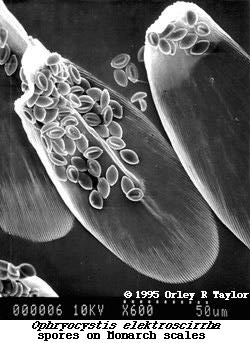
| M o n a r c h W a t c h | |
| Biology |
Anatomy
Sexing
Monarchs
Life
Cycle
Sensory
Systems
Predation
Parasite
Control
Systematics
Seasonal
Populations
Western
Population
Population
Genetics
Theories in
Evolution &
Population
Genetics
| Predation : Ophryocystis elektroscirrha | ||
This parasite develops inside the Monarch larva and pupa, and is transmitted from generation to generation by spores, which are shed from the scales of the adult female onto her eggs and the surface of milkweed plants as she lays eggs. The spores are also transferred between males and females during copulation (mating). Are there other means of spore transmission? This leads us to another important question, that is, how do the spores persist from year to year? Adult butterflies carrying the most spores, which they acquired as larvae, do not live as long as uninfested adults and few, if any, of these adults seem likely to survive the winter on the roost to carry the spore northward again in the spring. So, how does the spore persist in the population? One possibility is that spores are transmitted passively through close contact from infested to uninfested adults as they roost together during the migration. All the monarchs which had been infected as larvae might die during the winter but the spore could survive by adhering to scales on the wings and abdomen of otherwise healthy individuals.
These findings are consistent with the idea that this neogregarine parasite can persist from year to year through passive transmission of spores from infested individuals. However, more studies are needed. In particular, we need to know whether adults carrying spores which they acquired as larvae, actually survive the winter. We also need to establish the percentage of fall and spring migrants which bear spores and the "spore load" of the infested individuals. In Eastern monarch populations, the proportion of fall migrants with spores appears to be less than 5%. What should we expect from the spring migrants in terms of percentage infestation and average spore load? If you are trying to maintain a Monarch culture, there are steps that can be taken to control this parasite. There are still many questions about infection levels during spring and fall migration, survivorship of infected adults during the winter, and how many spores infected adults in nature actually carry. Can you think of other questions about this parasite and its relationship to monarchs? Introduction : At Overwintering Sites : By Invertebrates, Parasitoids & Disease |
|
m o n a r c h @ k u . e d u |
 Students taking Chip Taylor's 1994 course in Experimental Field Ecology examined the possibility of passive transmission of Ophryocystis elektroscirrha spores. Sonia Altizer and Karen Oberhauser suggested that spores could be sampled by applying a strip of clear scotch tape to the abdomen to remove a thin layer of scales. The tape is applied to a slide and examined under a microscope at 100x for spores. The spores are counted in a 1cm squared box drawn on the area of the tape containing the scales. In the classroom study the infestation rate was quantified using a scale of zero to four, with zero being no spores and four being >1000. The students caught 12 wild males, each had an infestation level of zero. The males were housed in a 2 foot square cage with eight laboratory reared males all of which had infestation levels of four (thousands of spores). The cage was provided with "butterfly nectar" so the adults could self feed, and every three days, four of the wild-caught butterflies were sampled for spore infestation. This sampling continued until each wild-caught butterfly had been sampled twice or had died. The students found that 75% (8 out of 12) of the wild-caught butterflies became contaminated with spores. The results indicate passive transmission of the spores occurs through non-mating contact with other butterflies and with substrates where infested butterflies have been housed.
Students taking Chip Taylor's 1994 course in Experimental Field Ecology examined the possibility of passive transmission of Ophryocystis elektroscirrha spores. Sonia Altizer and Karen Oberhauser suggested that spores could be sampled by applying a strip of clear scotch tape to the abdomen to remove a thin layer of scales. The tape is applied to a slide and examined under a microscope at 100x for spores. The spores are counted in a 1cm squared box drawn on the area of the tape containing the scales. In the classroom study the infestation rate was quantified using a scale of zero to four, with zero being no spores and four being >1000. The students caught 12 wild males, each had an infestation level of zero. The males were housed in a 2 foot square cage with eight laboratory reared males all of which had infestation levels of four (thousands of spores). The cage was provided with "butterfly nectar" so the adults could self feed, and every three days, four of the wild-caught butterflies were sampled for spore infestation. This sampling continued until each wild-caught butterfly had been sampled twice or had died. The students found that 75% (8 out of 12) of the wild-caught butterflies became contaminated with spores. The results indicate passive transmission of the spores occurs through non-mating contact with other butterflies and with substrates where infested butterflies have been housed.
 All material on this site © Monarch Watch unless otherwise noted.
All material on this site © Monarch Watch unless otherwise noted.